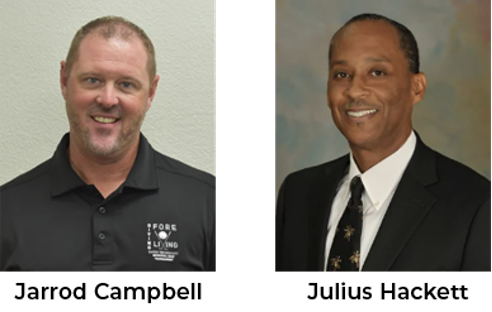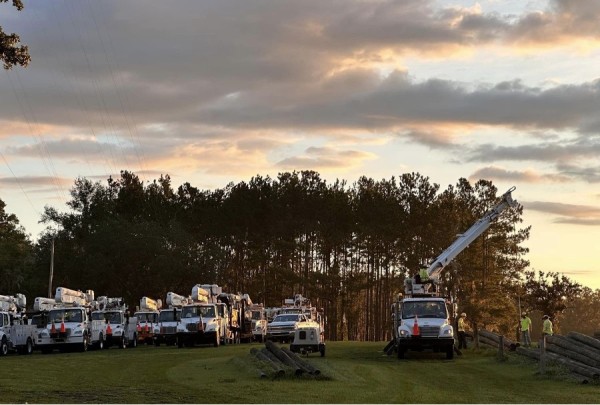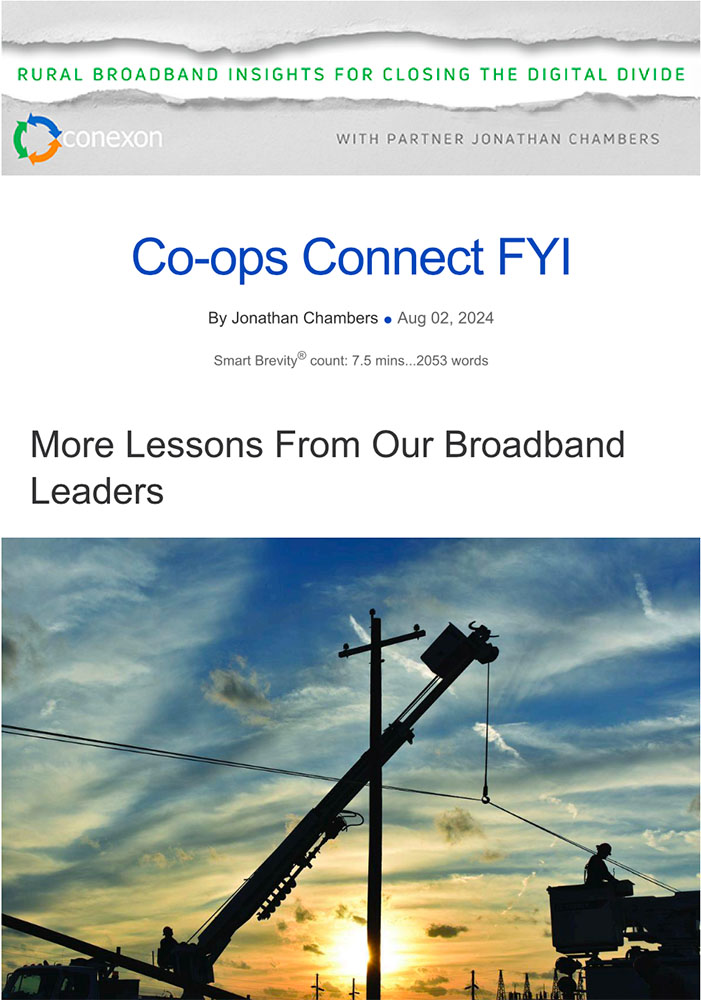More Lessons From Our Broadband Leaders
August 2, 2024
Earlier in July, I had the pleasure of a conversation with two more compelling electric co-op leaders:
- Jarrod Campbell, CEO, Osage Valley Electric Cooperative, Missouri
- Julius Hackett, CEO, Tri-County Electric Cooperative, Florida

The discussion occurred at the last of Conexon’s summer webinars, where we’ve focused on the role of electric co-ops in delivering broadband access to 100% of members across rural America.
We talked about broadband challenges and achievements, from federal funding processes, to project timelines, to cooperation among cooperatives, and more. I encourage you to take the time to go back to listen if you can; you’ll thank me. (Request the webinar recording)
In their own words, here’s just the start of what we learned from Jarrod and Julius.
On Getting Started

Photo: Tri-County Electric Cooperative
“As rural as we are, there are always reasons not to move forward with these projects, thinking that because of the density, you can’t make the math work. But I would challenge everyone to take a hard look at the mechanics of the math, look at the feasibility studies and see if these projects can actually come to fruition.
“We’re an agricultural service area, consistent with what we hear from our fellow co-ops across the United States: wide open and rural. This has been a great project for us, and we’re hoping that, as a highly rural co-op, we can stimulate growth in our territory.”
Julius Hackett
“Electric co-ops think they need a certain density meters per mile of line or they can’t make broadband successful. I would challenge them to look at ways they can make it happen because it’s been a success for us.
“We have 50 co-op employees. We serve about 18,000 meters across about 3,700 miles of line. When we do the math on it, it’s about 4.6 meters per mile of line. We’re a relatively low-density cooperative for a rural broadband project, and it’s been a huge success.”
Jarrod Campbell
On the Impact of RDOF

Photo: Osage Valley Electric Cooperative
“In 2020, Randy Klindt presented a map that showed Osage Valley Electric as one of the most lucrative RDOF areas in the country. We went on a whirlwind tour around Missouri to get a better feel for how it might work. Then we had Conexon conduct a feasibility study for us. Our Board looked at the numbers and made a decision. They were very upfront that we weren’t going to build just to certain areas. If we were going to do this, we would build to every meter on our system.
“We went into the RDOF auction feeling good about the capital expenditure cost for our project compared to the available RDOF funds. We started bidding as part of Conexon’s Rural Electric Cooperative Consortium (RECC) – and throughout round one, round two, round three: unsuccessful, unsuccessful, unsuccessful.
“By round eight, we hadn’t won one census block group. I’ve never forgotten this night. I called Jonathan and told him: ‘The financials aren’t there for us. The board had directed me not to jeopardize the financials of the cooperative — we’re going to have to step out.’
“That night, Jon said: ‘Let me take over the bidding for you. Let Conexon do the bidding for you. We’ll visit about an ownership model after the auction, but let’s see if we can start being successful.’
“That’s how the Connect model landed for us. We’re a Connect project because of that night. The next day, Conexon started winning a little and won a few more census block groups throughout the next few rounds.
“It’s been a very fast, very successful project, but it was the RDOF auction process that led us to where we are today.”
Jarrod Campbell
“We didn’t jump out there hoping to be the first one, but we were. We were interested in providing broadband, or having a way to provide broadband, to our members. We definitely saw the need. This goes back as far as 2010. For an extended period of time, we monitored what was available and watched what was working across the United States.
“Then in 2020, Conexon and the RECC shared information on the RDOF dollar potential in our footprint. There was actually a substantial award in our territory. We thought it sounded like an opportunity to finally make this happen. We chased down a lot of rumors and misinformation first, but eventually it turned out after going through all the feasibility studies, Conexon provided the best fit for our co-op and the best fit for our members.
“We just happened to be the first one to jump into the deep side of the pool and say we were ready. Our Board was ready, and our membership was certainly ready for us to take the plunge.”
Julius Hackett
On Project Timelines

Photo: Tri-County Electric Cooperative
“As our project finishes, it’s great to know the big sigh of relief is coming. I remember the day of our announcement like it was yesterday. At that point, we were still trying to manage expectations and told them it could be a four-year build. Some members said, ‘Four years? You’ve got to be kidding. I can’t wait that long.’
“We connected our first member in January of 2023 and started looking harder at the fiber build rate. We asked our project manager: ‘Can we pick up the pace and just let the horses run?”
“Once he told us we were free to roll forward, we unleashed all of the resources to make it happen. All signs pointed to ‘Burn through the project as quickly as you can so you can get on the other side of it and start enjoying it.’
“That seems to be the strategy that’s worked well for us. Our members certainly appreciated it.”
Julius Hackett
“We were one of the first Connect projects in the country. There’s nothing out in our rural areas except corn and soybeans and our lines. Our members’ excitement is one reason that we picked up our pace. We went into this with a five-year timeframe from the feasibility study, and pressure from members is why we built it out in just over 2.5 years. It always been positive pressure, but our members needed broadband yesterday.
“That’s one reason we were able to construct 3,200 miles of line in such a short time. We have not hired one employee at the cooperative since we started this project, and I’m proud of that. If you’re looking at building broadband in your cooperative, you don’t have to hire employees, but you can’t be afraid to go to work.”
Jarrod Campbell
On BEAD Funding

Photo: Osage Valley Electric Cooperative
“We feel very positive going into BEAD. There are a lot of very small rural towns served by the investor-owned utilities (IOUs) across our service territory that don’t have broadband service at all. So those opportunities lie ahead. They’re all begging us to come, but when you build at the pace we build, your financials take a hit. We’ve spent a lot of money in a short time, and we can’t go into these cities to build without government help.
“BEAD funding is critical for us to fill the holes of this Swiss cheese. We will gladly provide power or broadband to these rural areas if we are able to be successful with BEAD.”
Jarrod Campbell
“For BEAD, we are going to sit back and look at an opportunity to use those dollars to serve the IOU customers and potentially consider movement toward the west, joining a neighboring co-op to see if there is an opportunity to expand our network.
“What we’ll focus on initially is the communities we serve or serve around. By that time, the BEAD monies should be clearly defined, and we’ll be ready to jump in and close the gaps as quickly as we can. We’re certainly interested in expansion and don’t want to limit service to just our co-op members.”
Julius Hackett
On the Connect Model
Photo: Osage Valley Electric Cooperative
“Our board recognized that bringing broadband is the same type of life-changing activity as bringing electricity to rural America was for some of these farmers out here. We were left to fill the void for an entire service territory without broadband. I think that pressure is going to continue to mount on co-ops that don’t do it.
There are methodologies through the Connect model and other models that allow people to get service to their membership. It’s the first thing legislators ask our co-op about. They applaud us for doing it, but it was just the right thing to do for us.
We’ve tried to do a great job of service. Co-ops always hang their hat on service, and we do that no differently with the broadband project than we do with electric service. We go to school, we go to church, we go to ballgames. We see our members, they see us.
The take rate has been off the chart without having to do a lot of advertising, to be honest, because it sells itself when we’re from the Show-Me State. When you start proving yourself, it sells itself.
Even though we’re a Connect project, the co-op’s name is still right there with the project. People walk right in our co-op door and try to sign up every day. It’s great that they relate Conexon Connect with the cooperative because it helps sell the project for all of us.”
Jarrod Campbell
On Advice for Other Co-ops

Photo: Tri-County Electric Cooperative
“I recommend taking the temperature of the membership by doing some survey work to find out what the members are saying. I would also definitely encourage co-ops to move forward with a feasibility study to see what the math looks like. It may be a pleasant surprise rather than to their detriment. It’s always good to be able to make the decision based on concrete numbers.
“There are plenty of co-ops now who have jumped into this game. The co-ops are tremendously transparent with each other, open to having conversations and open to letting you to review the books if you desire. There are a lot of experience to be gained just by talking to your neighbors. We valued the conversations we had with our Georgia co-ops, and they provided some really strong insights.
“Conversations within the co-op family can really be valuable and tip the scales toward moving forward.”
Julius Hackett
“Osage Valley had a lot of different hurdles with low density, 4.6 meters per mile. The government funding didn’t play out as big as we were hoping, but our story has been a huge success.
What I will say to co-ops considering broadband is this: You don’t have to reinvent the wheel. One of our seven cooperative principles is ‘Cooperation Among Cooperatives’. I can’t thank the cooperatives of Missouri enough. We had neighbors across the state building broadband, and they opened their doors to us. We visited with three of them, and they opened their financial books, the construction methods, the designs – every question we could ask, they worked with us on.
Likewise, our door is open if people want to call or come visit us. We’re proud of what we’ve done here and excited to show it off.
I think there are opportunities for co-ops if they look at the models available and learn from their neighbors. Don’t just look at the state you’re in; look at others across other states. There are opportunities out there available for you.”
Jarrod Campbell
Thank You

Over the course of our three summer webinars, we’ve had more than 80 leaders from 40 co-ops and community organizations across 18 states join us. Many more have requested the recordings.
Thank you to all who have listened, and thank you to those who read this weekly column, follow on social media, and are partners in supporting Conexon’s mission of bridging the Digital Divide with fiber broadband. We are deeply grateful to have every one of you as part of our story.
If you’ve missed any of the webinar content, you can request it from Conexon anytime.
Stay tuned for future installments in this column from co-op leaders as part of an oral history tradition on co-ops. There is always something new to learn from those who have tackled the obstacles and forged the path for others to follow.

